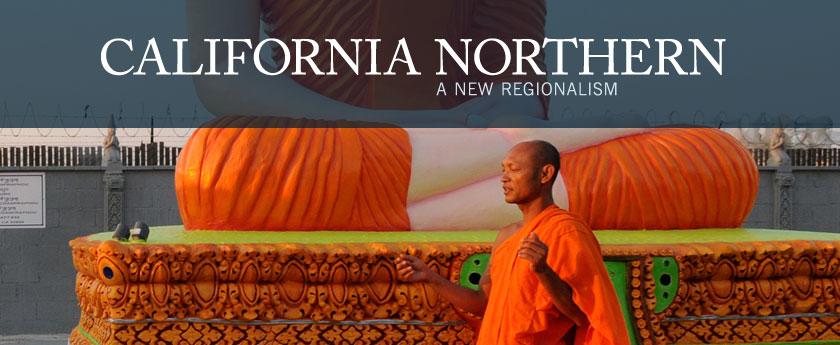Closer to Heaven
By Jennifer Torres Siders
In mid-April, at the start of Khmer New Year, mounds of sand with rounded peaks are piled up on the grounds of Wat Dhammararam Buddhist Temple in southeast Stockton. The mounds are called stupas, and there are five of them. The largest is about eight feet tall and represents the holy location where relics of the Buddha were buried. Surrounding it, at the cardinal points, are four smaller mounds, in honor of the Buddha’s favorite disciples.
During the three-day New Year festival, women sit at the base of the stupas, bundling incense sticks with stalks of silk flowers to sell to temple-goers who plant them, with their prayers, in the sand.
Months later, the mounds remain, though misshapen like tide-beaten sand castles. Ground squirrels riddle them with tunnels, and crabgrass sneaks along their sides. The stupas, sacred for three days, are left to erode and crumble once the New Year festival ends–the entire process a meditation on the ephemeral nature of existence.
Around the sand hills at Wat Dhammararam, though, is evidence of another, opposing force: the human will to endure.
For more than a decade, Kong Tith, a wry and wiry senior monk, has been driven–by dreams, he says–to build dozens of colossal Buddhist statues at the temple, located just off an industrial stretch of Highway 99 frontage. Rendered in chicken wire, wood and concrete, the statues were declared “absolutely spectacular” by a characteristically breathless Huell Howser visiting Stockton with his public television crew several years ago. Most of the pieces illustrate scenes from the life of Siddhartha Gautama, the man who would become Buddha: the infant Prince Siddhartha, miraculously taking seven steps just after his birth to Queen Maya; Siddhartha as a young man, cutting his hair off with a sword and renouncing his life of privilege; and, in the twelve-foot-high, fifty-four-foot-long showpiece of the temple, Siddhartha reclining serenely in the moments before his death.
Painted in brazen golds and blues, each statue is the realization of a vision that came to Kong in his sleep, he says. Dreams guide every step of the endeavor, from each sculpture’s subject to its location on the temple grounds. If Kong is mistaken in the smallest detail–if a statue’s painted eyes are gazing in the wrong direction, for example–another dream comes to correct him.
Kong says he builds the statues, in part, to soothe the grief that has long dogged his community of Cambodian immigrants, many of whom came to the United States as refugees fleeing terror and killing in their home country. “Many times, people come in from outside the temple. They’re angry,” Kong says. “When they see the Buddha, they calm down. Their minds calm down.”
The temple has come to serve as a repository of culture, a place where children, and even some adults, who grew up speaking English come weekly to study Khmer, the language of Cambodia. It is a source of civic pride to the families–their names engraved in walls and on plaques–whose modest donations have helped build and sustain the temple over three decades. It administers the prayers, blessings, and rituals that are central to Cambodian spiritual life and that offer sanctuary in the midst of personal and economic stress. “It teaches the younger generation the traditions of their ancestors,” said Kunthea Tuy, who oversees traditional Cambodian dance classes at a central Stockton community center. Her students perform annually at the temple.
This is an excerpt of “Closer to Heaven”

